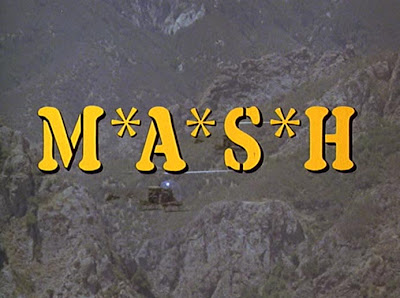 I never really was a watcher of the classic show M*A*S*H, especially when I was a kid. It took me all of 5 minutes of viewing to understand that this supposed sitcom was actually a serious drama, dealing with grown-up emotions that had little relevance to me at the time. Plus, I had no interest in war. I was into Star Wars, not real wars.
I never really was a watcher of the classic show M*A*S*H, especially when I was a kid. It took me all of 5 minutes of viewing to understand that this supposed sitcom was actually a serious drama, dealing with grown-up emotions that had little relevance to me at the time. Plus, I had no interest in war. I was into Star Wars, not real wars.Even the kid-aimed M*A*S*H videogame, which had you fishing for bullets out of a patient's innards, kind of like a virtual version of the classic electronic game Operation, couldn't lure me into watching the actual show.
 Sorry, marketing wizards!
Sorry, marketing wizards! That said, the show still managed to occupy the family TV screen quite a bit. Syndicated reruns seemed to be on at least twice a day, so I'd end up being exposed to episodes here and there, while waiting for some other show to come on afterwards (yep, in the pre-cable days, with only a few channels to choose from, you sometimes just had to squat and wait it out.)
That said, the show still managed to occupy the family TV screen quite a bit. Syndicated reruns seemed to be on at least twice a day, so I'd end up being exposed to episodes here and there, while waiting for some other show to come on afterwards (yep, in the pre-cable days, with only a few channels to choose from, you sometimes just had to squat and wait it out.)One of the more unusual episodes of M*A*S*H occurred in the 8th season. Titled "Dreams", it takes us into the minds of several characters as they nod off briefly during an extended 30-hour operating room session.
The dreams were surreal and unsettling, nightmarish enough to force this young non-fan to sit up and pay attention (and to still remember them 30 years later).
HOULIHAN'S DREAM
Head nurse Major Margaret Houlihan barely makes it back to her barracks in time to pass out in her bunk...
 ...only to sit up seconds later, dressed as a bride.
...only to sit up seconds later, dressed as a bride.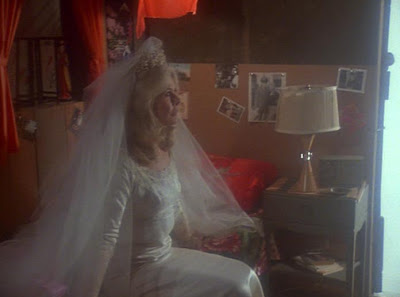 There are no glistening harps, slow dissolves, or soft-focus photography to transition us between the real world and the dream. The dream starts happening as though occurring in reality--just as it would seem to the dreamer. Houlihan finds herself running through a field, into the embrace and bed of a well-dressed groom.
There are no glistening harps, slow dissolves, or soft-focus photography to transition us between the real world and the dream. The dream starts happening as though occurring in reality--just as it would seem to the dreamer. Houlihan finds herself running through a field, into the embrace and bed of a well-dressed groom. A patrol of soldiers marches by, taking the groom with him, who steps robotically in line.
A patrol of soldiers marches by, taking the groom with him, who steps robotically in line.
 Houlihan is kept from following her groom when a dirtied hand grabs her shoulder. She turns to find the bed now piled with wounded soldiers.
Houlihan is kept from following her groom when a dirtied hand grabs her shoulder. She turns to find the bed now piled with wounded soldiers.
 She suddenly finds herself standing alone, covered in blood.
She suddenly finds herself standing alone, covered in blood.
WINCHESTER'S DREAM
Major Charles Winchester "the Third" grabs a quick nap on a cot, only to awake seconds later dressed as a magician.

 Giving dual meaning to the term "operating theater", Winchester begins performing traditional magic tricks for an audience of adoring surgeons.
Giving dual meaning to the term "operating theater", Winchester begins performing traditional magic tricks for an audience of adoring surgeons.

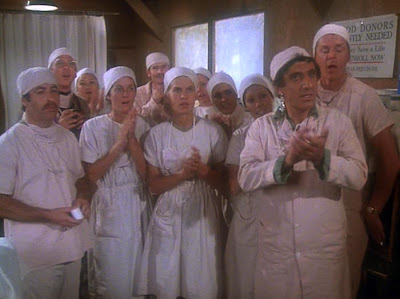 But the show is interrupted when a stretcher bearing a wounded soldier rolls through the crowd and positions the dying man in the front row.
But the show is interrupted when a stretcher bearing a wounded soldier rolls through the crowd and positions the dying man in the front row. The soldier agonizes for several minutes before finally expiring...
The soldier agonizes for several minutes before finally expiring... ...leaving the desperate-faced Winchester doing an impotent tap dance as his final act.
...leaving the desperate-faced Winchester doing an impotent tap dance as his final act.
FATHER MULCAHEY'S DREAM
The reverend Father Francis Mulcahey is hearing an impromptu confessions from a soldier when he dozes off...
 ...and finds himself apparently elected Pope, being hoisted by an enthusiastic crowd.
...and finds himself apparently elected Pope, being hoisted by an enthusiastic crowd.
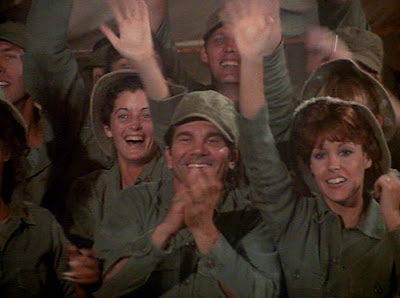 He is about to read a passage from the Bible when drops of blood begin splattering down on the pages from above.
He is about to read a passage from the Bible when drops of blood begin splattering down on the pages from above.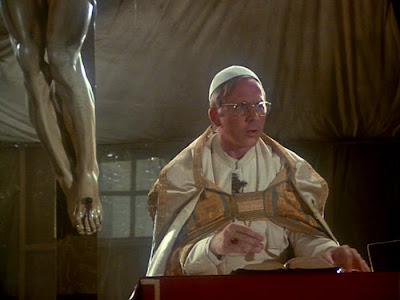
 He looks up to find the statue of Jesus has become the corpse of a solder.
He looks up to find the statue of Jesus has become the corpse of a solder.
HAWKEYE'S DREAM
For me, Capt. Benjamin "Hawkeye" Pierce's dream was the most disturbing. He puts his head down for a quick cat nap in the mess hall...
 ...and is awakened by an instructor in some kind of medical class, who orders Hawkeye to remove his own left arm as punishment for sleeping during the lecture.
...and is awakened by an instructor in some kind of medical class, who orders Hawkeye to remove his own left arm as punishment for sleeping during the lecture. Confused, Hawkeye grabs his left arm and twists it out of place. It has turned into the lifeless arm of a mannequin.
Confused, Hawkeye grabs his left arm and twists it out of place. It has turned into the lifeless arm of a mannequin.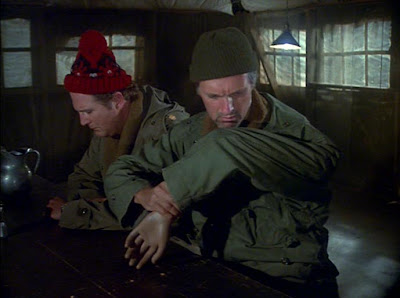 The instructor intends to demonstrate how to reattach it, using a live model who is already missing his arm.
The instructor intends to demonstrate how to reattach it, using a live model who is already missing his arm. When Hawkeye admits he doesn't know the procedure, he loses his other arm.
When Hawkeye admits he doesn't know the procedure, he loses his other arm. The instructor tosses the arm off-camera where it lands incongruously with a splash into a lake. An armless Hawkeye is now drifting helplessly among floating limbs.
The instructor tosses the arm off-camera where it lands incongruously with a splash into a lake. An armless Hawkeye is now drifting helplessly among floating limbs.

 A bloodied Korean child beckons him from the bank.
A bloodied Korean child beckons him from the bank. Hawkeye finds himself standing over a would-be patient, unable to reach for the offered scalpel...
Hawkeye finds himself standing over a would-be patient, unable to reach for the offered scalpel... ...and screams as the sound of choppers approaching indicate the arrival of more wounded.
...and screams as the sound of choppers approaching indicate the arrival of more wounded. The "Dreams" episode of M*A*S*H can be found on DVD here.
The "Dreams" episode of M*A*S*H can be found on DVD here.
























